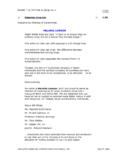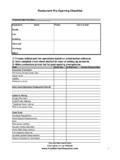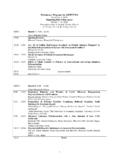Transcription of Temporo-Mandibular Joint Complex Exercise Suggestions
1 Temporo-Mandibular Joint Complex Exercise Suggestions I. Exercise Generalizations: A. Patients with post-traumatic TMJ problems or with recent-onset dysfunction that is largely posture-related will generally progress quickly. Once existing mechanical dysfunctions are corrected, emphasis of treatment can be education on maintenance of good posture and oral habits. B. Patients with chronic TMJ dysfunction of a non-traumatic nature are less likely to progress quickly. Often, they are systemically hypermobile, with less than optimal connective tissue quality. It is important that patients understand this and recognize the need for a long-term personal commitment to rehabilitation and musculoskeletal fitness.
2 II. Exercise Techniques: A. Rocabado s 6x6 Exercise Program Rocabado advocates the instruction of six fundamental components of activity for treatment of TMJ dysfunction. He recommends that patients complete each activity 6x/session and 6x/day. The activities are as follows: 1) Tongue Clucking making a clucking sound positions the tongue against the hard palate in the correct resting position for appropriate nasal and diaphragmatic breathing. Once the activity is practiced, the patient is to attempt to maintain appropriate tongue / jaw resting position throughout normal activity. 2) Controlled TMJ Rotation on opening Patients are taught to maintain their tongue on the hard palate while opening and closing the jaw.
3 This position limits opening to rotational portions only and prevents excessive protrusion of the mandible. This range of motion is to also be utilized during chewing, to control hypermobility. 3) mandibular Rhythmic Stabilization Patients apply resistance to opening , closing, and lateral deviation with the jaw in a resting position. The goal is to promote normal positioning of the jaw while maintaining appropriate postural alignment. 4) Upper Cervical Distraction Patient performs upper cervical flexion while stabilizing the cervical spine with a hand-collar . The goal is to relieve neurovascular compression in the upper cervical spine by distracting the occiput from the atlas. 5) Axial Extension of the Cervical Spine Patients perform cervical retraction movements, effecting upper cervical flexion at the same time as lower cervical extension.
4 The goal is to normalize forward head posture and to normalize the mechanical relationship of the head, neck, and jaw. 6) Shoulder Girdle Retraction Patients perform retraction and depression of the scapulae in relation to the rib cage. The goal is to normalize upper quarter posture and mechanical relationships. B. Exercise for Neutral Posture 1) Attain / Maintain Neutral Upper Quarter Posture - Patients should be taught to stabilize the shoulder girdle and to keep the cheekbone aligned over the sternum and pubic bones. This may require a variety of exercises, including stretching of the suboccipitals, levator scapulae, scalenes, or anterior shoulder girdle musculature. Cervical isometrics may be appropriate in static or dynamic environments.
5 Shoulder stabilization activities such as push-ups, rowing, scaption movements, or upper extremity movements in neutral posture may also be indicated. 2) Anterior Cranial Rotation Exercise Chin nods or cervical retraction in a variety of postures can help to maintain normal alignment of the jaw and upper cervical region. Performing these activities in a trunk-flexed position can help to induce relaxation of jaw elevators and retruders. 3) Nasal Breathing Practice attaining and maintaining normal resting position of the jaw, with the tongue on the palate, lips closed, and teeth slightly apart. C. Exercise for TMJ Mobility 1) Functional Jaw opening Patient performs opening movements with condylar rotation but not translation.
6 External palpation of the condylar head with an index finger, as well as maintenance of the tongue on the palpate, help provide feedback. Positioning with a mirror can help limit movement deviations. Controlled opening facilitates Joint mobility, good circulation to the condylar head, cartilage conditioning, relaxation of the pterygoid muscles, and neuromuscular control of a hypermobile Joint . 2) Controlled-ROM Lateral Deviation From a resting jaw position, patient performs lateral deviation until the canine tooth on the lower jaw matches the canine tooth of the upper jaw. Patient may be positioned in front of a mirror or may also palpate the condylar head with 1 finger and the upper canine tooth with another finger to cue movement limitations.
7 Controlled lateral deviation causes distraction of the Joint capsule, which can help attain ROM, improve Joint mobility and circulation, and control muscular spasm. 3) Lateral Deviation + Functional opening From a resting jaw position, patient performs controlled-ROM lateral deviation followed by controlled-ROM opening . Movement may be monitored as above with self-palpation and positioning with a mirror. This movement causes distraction of the Joint capsule. 4) Protrusion ROM From a resting jaw position, patient performs protrusion of the mandible followed by retrusion back to a resting position. A mirror can help patient to perform the movement in midline and with good neuromuscular control.
8 5) Self-stretch into opening From a neutral posture and resting jaw position, patient opens in midline and then provides a mild overpressure to the top and bottom teeth at end-range. This can also be accomplished using a popsicle-stick levering system. Prolonged stretching may also be recommended to increase opening ROM. 6) Self-distraction Mobilizations From a sitting position, patient rotates the head slightly to the opposite side of the involved Joint . The mandibular condyle is palpated with 1 finger while the other thumb and fingers are placed on the mandible as in a passive mobilization technique. Distraction is provided by active wrist ulnar deviation. D. Exercise for TMJ Stability 1) Isometric Contractions of Jaw in Neutral From a neutral posture, patient opens jaw to neutral and stabilizes mandible with bilateral thumbs under jaw and index fingers between top and bottom teeth.
9 Gradual application of submaximal resistance is applied in directions of lateral deviation, protrusion/ retrusion, or opening / closing. 2) Isometric Contractions of Supra/Infra-hyoid Muscles From a neutral posture, patient nods head forward approximately 15 degrees. One hand palpates the hyoid bone (anterior to C2-C3 vertebra) while the other applies 1-2 fingers resistance to upper cervical flexion. The hyoid bone will push the palpating fingers forward slightly as the muscle contraction occurs. 3) Isometric Cervical Flexion in Forward Trunk Flexion Patient sits in trunk flexion with frontal bone supported on forearm as the head rests on a table. Patient actively nods head anteriorly 15 degrees, while maintaining the jaw in resting position.
10 4) Resisted Lateral Deviation Out of Neutral From a neutral posture, patient laterally deviates the jaw away from the involved side until the top and bottom canine teeth match. Then, maintaining teeth slightly apart, the patient provides 1-2 fingers of resistance to ipsilateral lateral deviation. This helps to stabilize the articular disc on the condylar head by strengthening its lateral ligament attachments. E. Exercise for Jaw Muscle Relaxation 1) Controlled opening in Forward Trunk Flexion From a sitting position with trunk flexed and head supported on patient s forearm, active opening to approximately 10 mm is performed. Closing occurs to resting jaw position. Gravity assists in anterior traction of the mandibular condyles.




